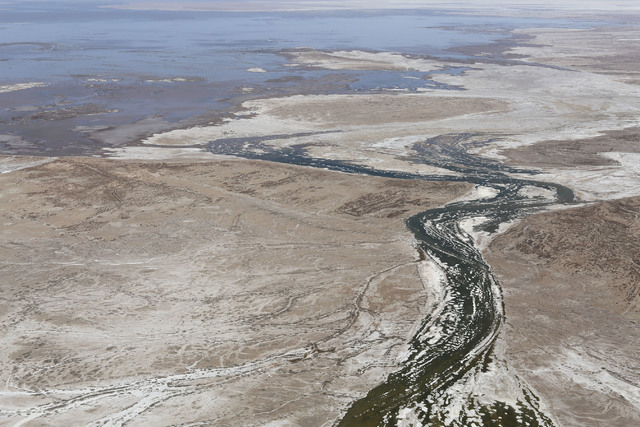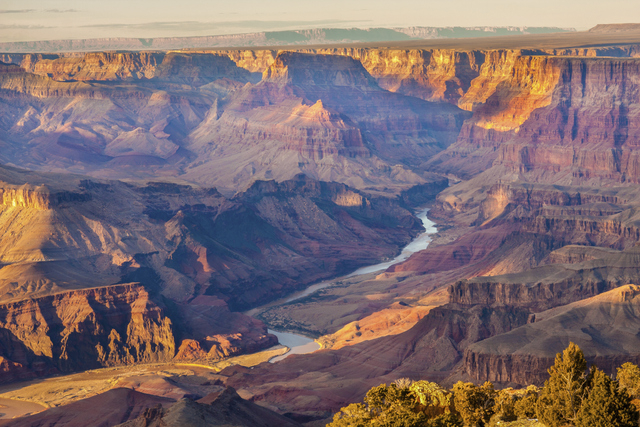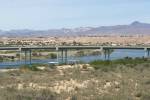Cooperation keys latest pact to protect Lake Mead
Eighty years ago, Arizona sent national guard troops in commandeered ferryboats to try to stop California from diverting more water from the Colorado River.
A lot has changed since the days of the “Arizona Navy.”
Now the two states have joined with Nevada on yet another cooperative effort aimed at saving drought-stricken Lake Mead by giving up some of their own hard-fought water resources.
The latest pact calls for the three states and the U.S. Bureau of Reclamation to set aside 740,000 acre-feet of water over the next three years and up to 3 million acre-feet by 2020 to slow the decline of the shrinking reservoir.
If successful, the series of “pilot drought response actions” could keep the reservoir from dipping below a critical shortage line that would require Nevada and Arizona to cut their Colorado River use.
But the effort is about more than staving off the first-ever shortage declaration on the river, said John Entsminger, general manager of the Southern Nevada Water Authority. It’s part of what he called a “major evolution on the river,” which was once governed by bitter infighting and self-interest. Today, he said, water users seem to recognize “everybody’s stake in maintaining a healthy river system.”
“We’re all in this together,” Entsminger said, and keeping Lake Mead from shrinking too far “is good for everyone.”
“That mindset has been building over the past decade, in my opinion,” he said.
The new agreement was signed in Las Vegas late last week during the annual meeting of the Colorado River Water Users Association. Entsminger said it provides a basic road map for more specific plans that will be developed and negotiated starting early next year.
Arizona has committed to leaving 345,000 acre-feet of water in Lake Mead over the next three years, while California would leave 300,000 acre-feet and Nevada would leave 45,000 acre-feet. Another 50,000 acre-feet will come from the Bureau of Reclamation through efficiency improvements, mostly at the southern end of the river where much of its flow is diverted for agriculture near the U.S.-Mexico border.
That initial 740,000 acre-feet of so-called “protection volumes” represents enough water to supply the Las Vegas Valley for more than three years. The larger goal of the new pilot program is to sock away 1.5 million to 3 million acre feet in Lake Mead over the next five years.
One acre-foot is enough to supply two average valley homes for more than a year. As a general rule, the surface of Lake Mead rises about one foot for every 100,000 acre-feet of additional water, so the program could restore 30 feet or more to a reservoir that has seen its surface drop by 130 feet since record drought took hold on the Colorado River in 2000.
The lake now sits at about 1,086 feet above sea level, but current federal projections call for it to drop by about 6 feet to a new record low by April and to shed a total of 20 feet by June of 2016.
Those estimates do not take into account the water that would be kept in the lake under the new agreement.
At least a portion of the water from the states will stay in the lake with no promise of getting it back if conditions improve.
Entsminger said Nevada can meet its 45,000 acre-foot commitment under the agreement without pumping a drop, since the Las Vegas Valley only consumes about 220,000 acre-feet of the state’s annual river allotment of 300,000 acre-feet. The authority also could pump some of its groundwater holdings in Coyote Springs Valley or use its surface water rights on the Virgin and Muddy rivers to help meet Nevada’s 45,000 acre-foot share.
The authority has left a portion of its unused Colorado River water behind to help boost Lake Mead for the past several years, he said.
Keeping Lake Mead from dropping is of particular concern in the Las Vegas Valley, which draws 90 percent of its water from the reservoir through two intake pipes that will stop working should the lake level fall below 1,000 feet above sea level.
The water authority is on track to finish a new, $817 million deep-water intake at Lake Mead by next summer. Authority board members signed off last week on plans to build a $650 million pumping station that will allow the new intake to continue working even if the lake drops more than 200 feet from where it is now.
The new agreement comes on the heels of another water-saving pact struck in July by the four largest communities fed by the river. The Colorado River System Conservation Program will pay farmers, cities and power plant operators to conserve, keeping the unused water in Lake Mead.
That program was seeded with $11 million from the Southern Nevada Water Authority, the Central Arizona Water Conservation District, the Metropolitan Water District of Southern California, Denver Water and the Bureau of Reclamation.
Contact Henry Brean at hbrean@reviewjournal.com or 702-383-0350. Find him on Twitter: @RefriedBrean.































